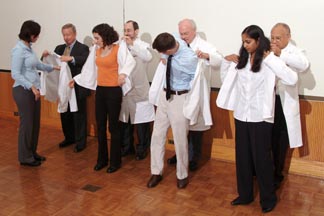Assuming the mantle: White coat ceremony ushers medical students into lifetime at the bedside
By Melissa Hantman

NEW YORK - Forget fashion forecasts - the Class of 2009 knows its color of choice for the next four years. As they donned their white coats Aug. 24, they officially assumed the mantle of the medical student.
Helping 102 doctors-in-training into their garb at the annual "white coat ceremony" were Antonio M. Gotto Jr., dean of the Weill Cornell Medical College (WCMC); Bruce Ballard, associate dean for student affairs and equal opportunity programs and associate professor of clinical psychiatry; and Carol Storey-Johnson, senior associate dean for education and associate professor of clinical medicine.
"These coats are a symbol of medicine," Ballard said in his opening remarks. "When you wear them, others will expect a certain level of knowledge, expertise, care and compassion."
He emphasized WCMC's unusual integration of basic science and clinical practice throughout the curriculum. Students meet with patients from the start to begin to cultivate a "bedside" manner. "Tomorrow, you will wear the very white coats you don today," he said.
David Silbersweig, associate professor of psychiatry and neurology, discussed his own career path. Raised in a family of doctors, he initially resisted the family tradition, instead studying philosophy. But his meditations on the mind ended up drawing him back to medicine, raising questions that he would seek to understand through neuroscience. Twenty-three years ago, he moved into Olin Hall, the Medical College dormitory.
"We grow into our white coats," Silbersweig told the students. "At first, you may feel like an imposter. But the coat is transformative. There's a sacred trust associated with the white coat."
As medicine changes at a blistering pace, he said, the white coat reminds the doctor of immutable core values: compassion, attentiveness and empathy.
"Listen to your patients; give them your undivided attention, even when you're harried," he said. "We should endeavor to show to others the same respect the white coat engenders."
Gotto welcomed the students, calling them "a highly accomplished and select class, with the promise of making contributions to medicine and society."
He said, "You come from extremely diverse backgrounds, interests, accomplishments and talents."
The students are from 52 undergraduate colleges - with Cornell, Harvard and Yale the most widely represented - with degrees in 43 subjects and roots in 24 states and 16 countries. Woman make up 48 percent of the group, and the average age is 24.3 years.
The class has netted a great amount of international experience, with students having spent time working in Croatia, Denmark, Greece, the United Kingdom and Senegal. It's also a highly musical class - with percussionists, pianists, guitarists and flutists; one student even founded a record label. There are congressional interns, emergency medical technician volunteers and computer analysts.
Thomas Sculco, professor of orthopedic surgery and chair of the Department of Orthopedic Surgery, reminisced about his first days as a medical student 40 years ago. "You will join a profession like no other," he said. "Medical school begins a lifelong process of education, a commitment to lifelong learning."
He reminded the students to seek insight and enlightenment not only from professors but also from patients.
"Read, question, examine, listen, study, probe and seek out knowledge," he said. "Push the envelope to make our profession better. Your interests and passions will make you a better doctor."
And, he counseled, "Take advantage of all New York City has to offer. It will never cease to amaze you."
Media Contact
Get Cornell news delivered right to your inbox.
Subscribe